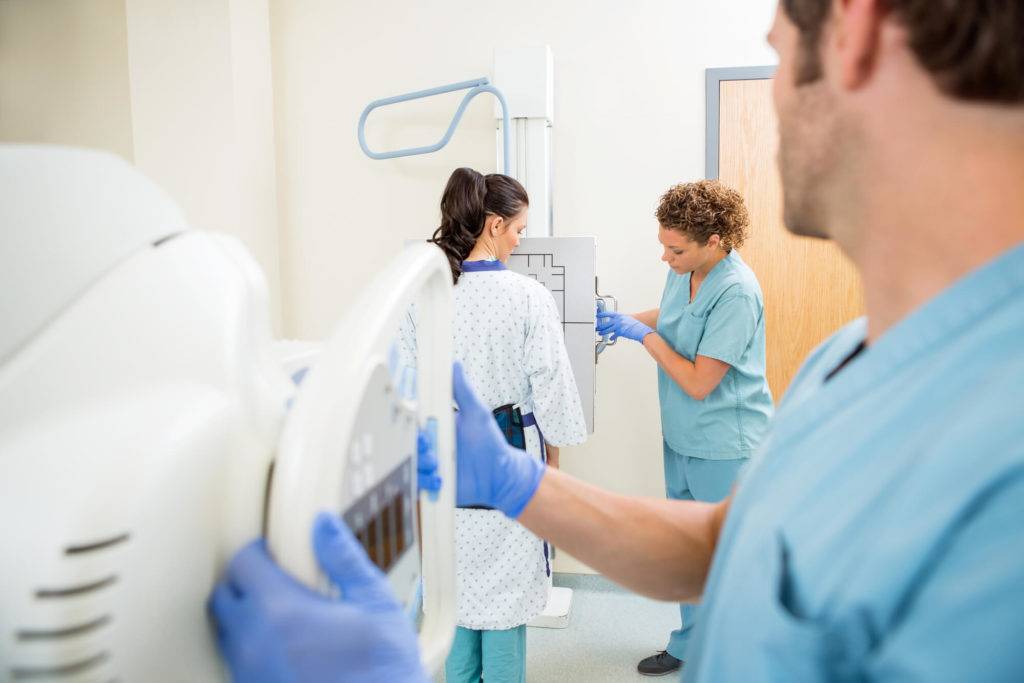How Digital X-Rays Work

Everything has gone digital, including your X-rays.
X-rays are common diagnostic tools used in healthcare clinics and emergency rooms around the world. They have been around since Wilhelm Roentgen discovered them in 1895, and medical technology continues to improve upon them.
Digital X-rays provide the same benefits as traditional X-rays, plus more.
How X-Rays Work
You produce X-rays by heating a negatively charged electrode with electricity. The process releases electrons and produces energy.
An X-ray machine directs the energy toward a metal plate called an anode at high velocity. As the energy collides with the atoms in the metal plate, it releases an X-ray. The X-rays then move toward a film cassette or cartridge to expose the film, just as clicking the shutter of a film camera allows the film to be exposed to light.
By placing dense materials between the X-rays and the film cartridge, you can capture images showing injury and disease impact to those materials without cutting away the softer tissue covering.
The X-rays move through soft tissue but are blocked by bones and other dense materials, leaving white areas on the film as the rest becomes black from exposure.
Digital X-Rays
Digital X-rays are also known as digital radiography. Unlike traditional X-rays, you don’t need film. Instead, you acquire, edit, and transfer the X-ray images to a computer system and generate a picture. You don’t need to wait for film development.
There are four steps to digital X-rays:
- Image generation
- Processing
- Archiving (storage)
- Presentation (viewing)
Image generation occurs by converting absorbed X-ray energy into an electrical charge, represented digitally in grayscale. The difference in shade indicates the quantity of energy absorbed at each point in the image.
Processing software produces the final image the doctor uses to make a diagnosis. Switching from film to digital X-rays eliminates noise and artifacts while enhancing any contrast used.
An X-ray technician positions your body and the X-ray equipment for optimal imagery of the body part in question. Then you stand still, the technician presses a button, and you’re done. The doctor may receive the X-ray at a computer terminal before you can even get dressed.
The Advantages and Disadvantages of Digital X-Rays
The benefits of digital X-rays are numerous:
- They provide an extremely high-quality image.
- The equipment streamlines the workflow.
- The staff can quickly process and diagnose from a digital X-ray.
- A digital X-ray detects photons more efficiently – at least 65% better than other computerized radiography systems.
Your doctor receives sharply detailed images of your broken bones, infected internal organs, and other problems painlessly and without an invasive procedure like surgery.
Digital X-rays do have a few minor disadvantages. Digital X-rays cost more than traditional X-rays. Digital radiography has high luminescence requirements and high-resolution monitors for viewing. It requires a high bandwidth archiving and communication system to store and retrieve the images, which are large computer files. The facility has to have the right technology to support digital x-ray usage.
Digital X-Rays vs. Traditional X-Rays
Traditional X-rays require film cassettes plus the equipment, room, and chemicals to develop the film. Film development and printing take time, plus you need the space to store the X-rays.
Digital X-rays don’t need film, chemicals, or anything else that requires later disposal. Instead, they need very bright light and high bandwidth storage. Electronic storage requirements are much reduced from the storage necessary for physical X-ray films.
Using Digital X-Rays for Diagnosis
Your healthcare professionals can use X-rays to take images of bones, joints, and some soft tissue. If you have ever been to the emergency room or doctor’s office for potential pneumonia, you’ve probably received a chest X-ray. Even though your lungs are soft tissue, infection is clearly visible as a brighter and more diffuse area on your lungs.
Digital X-rays provide an extremely sharp image of breaks and disease processes in bones and joints. Your doctor can visualize fractures, tumors, and other problems with your bones.
Beyond bones, an X-ray can also show swallowed objects. If your child swallowed a button battery or toy part, the X-ray shows where it is and the best pathway for retrieving it.
However, just like with traditional X-rays, you must remove any objects about your person before imaging, like jewelry, underwire bras, or anything made of dense materials. Otherwise, the resulting image may block an essential diagnostic field. Of course, digital radiography makes it much quicker and easier to take a new picture if needed.
The Risks of Digital X-Rays
X-ray imaging has always held some slight risk. X-rays produce ionizing radiation that can harm living tissue with excessive use. However, an individual X-ray exposes you to very little radiation, and digital X-rays reduce the exposure by 80% compared to a traditional X-ray.
If you are pregnant or suspect you may be pregnant, discuss the risks with your physician before allowing an image to be made. X-rays could harm the fetus at particular points in the gestational process, especially if you require multiple images.
In Summary
Digital X-rays are a vast improvement over traditional X-rays in everything but cost. Your doctor has bright, clear images to view, which improves diagnosis considerably. The facility also requires less storage space for the images. It can provide you with your images on portable media to go.
While X-rays have risks, as with most medical procedures, they are minimal. The benefits definitely outweigh the risk in most circumstances, especially in the emergency room.
Family First ER provides only the best of care to our patients, young or old, and that’s why we use digital radiography and digital X-rays in our facilities. We want to diagnose you as quickly as possible so we can get you healthy again.

